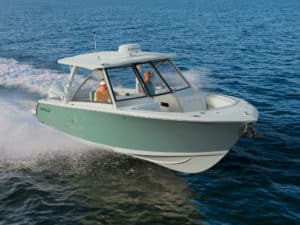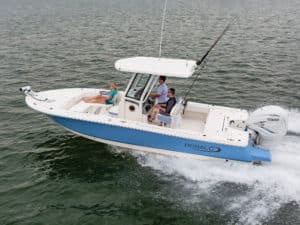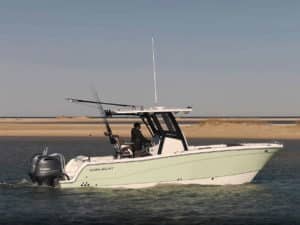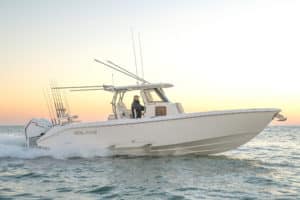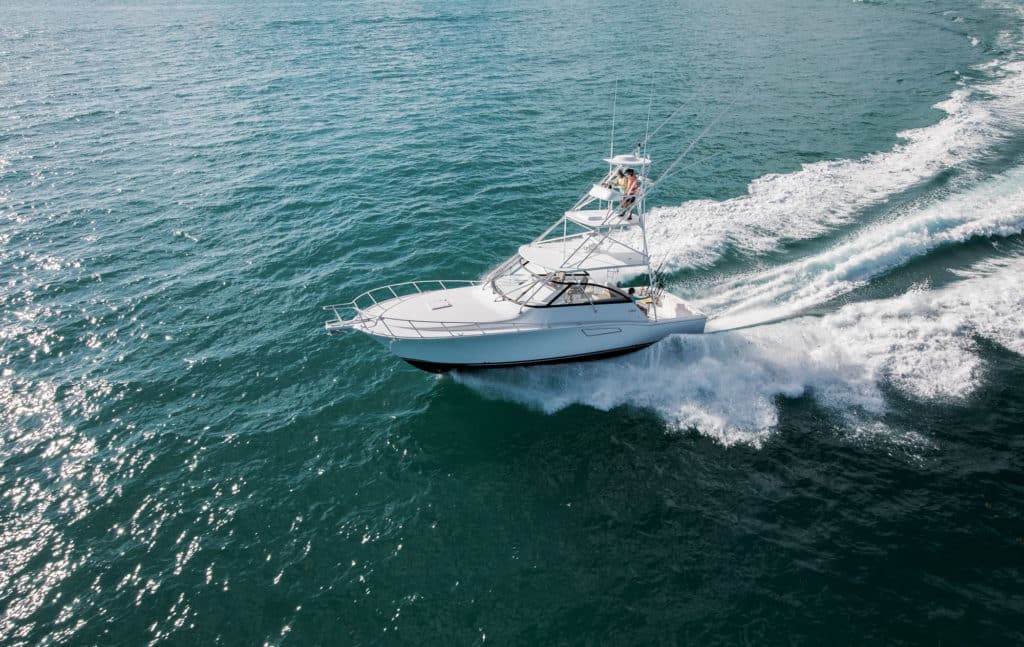
The Cabo name occupies a warm spot in my heart. I tested Cabo Yachts’ first model — the 35 Flybridge — in the early 1990s. I also own one of the original Cabo Marine models — the 216 CuddyCon — built in 1986. So, when production of Cabos was suspended in 2014, it struck a sad chord.
But now Cabo is back with the launch of the 41 by New Bern, North Carolina-based Hatteras/Cabo Yachts. Hull No. 1 debuted at the 2019 Miami International Boat Show, and afterward it traveled to the Ocean Reef Club in Key Largo, Florida.
That’s where I caught up to the 41 in early March for a morning of offshore fishing. Greeting me at the dock were Capt. Jeff Donahue, sport-fish segment director for Hatteras/Cabo, as well as mates Tyler Davis and Ben Pope. Before casting off, Donahue and Pope loaded about 20 goggle-eyes into the molded-in 48-gallon transom livewell in hopes of tangling with sailfish.
We unplugged the shore power and slipped lines. An optional joystick control at both the main helm and second station aloft, integrated with the twin Volvo Penta 725 hp D11 turbo-diesel inboards (an upgrade to the standard 625 hp D11s) and a bow thruster, made easy work of maneuvering the 41 in the tight quarters of the Ocean Reef marina.
Target Market As we idled out through the narrow channel, Donahue explained that the target market for the 41 consists of current owners of center-console fishing boats who are pining for more luxury and overnighting capabilities. “Our goal is to pull buyers from the center-console market,” he says. “We’re looking for buyers who want to upgrade from center-console with more accommodations such as air conditioning, mezzanine seating, a nice galley, comfortable berths and more.”
Indeed, the 41 abounds with creature comforts. Accessed via a step-down companionway on the starboard side of the bridge deck, the main cabin includes a convertible settee with a dining table to starboard and galley to port with rich, satin-finish European walnut cabinetry throughout. A flat-screen TV in the cabin lets you watch sports, news and other entertainment via satellite subscription.
I found elegant wood-cabinet rod stowage in lockers adjacent to the settee and a well-appointed head abaft the galley with a flush toilet, shower, vanity and sink. The 41 includes integrated rod stowage inside the shower. The master stateroom in the bow features wood accents and cabinetry, an island queen berth and hanging lockers.
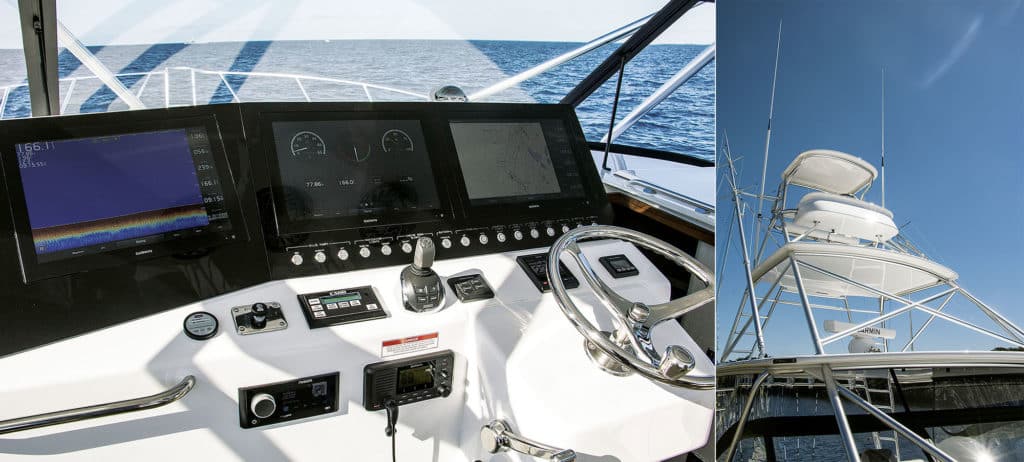
Two Helms Back topside, on the bridge deck, I found L-shaped seating to port, a centerline captain’s chair and a companion chair to starboard. A refrigerator to starboard proved to be a great place to access cold bottles of water while fishing. I also found tackle stowage in the module that contains the fridge. I will admit that the optional 24,000 Btu bridge deck air conditioning felt good on this sultry day. This is in addition to the 11,000 Btu air-conditioning unit for the cabin. Both are powered by an 11 kW diesel generator while away from the shore power.
The helm panel on my test boat featured three Garmin GPSMap 8622 multifunction displays, and the entire bridge was protected by a wraparound tempered-glass windshield with polycarbonate panels stretching from the top of the windshield to the hardtop to enclose the bridge deck on three sides.
Much of the piloting during my trip took place from the second station in the 41’s optional full tower. A 10 mph west wind blew off the beach, generating a 1- to 2-foot chop, and the Cabo with its deep-V hull and Carolina flare rode buttery smooth through the waves and handled marvelously as we zig-zagged our way around nav markers, crab pots and other boats en route to the offshore grounds.
Working the Deck We pulled back the throttle in 120 feet of water near Alva Chapman Reef. Driving from the tower, Donahue used the throttles to keep the 41’s bow into the wind. I half expected the idling diesel engines to be noisy and bothersome. In fact, at 600 rpm, the engines registered just 78 decibels using the A-scale on my sound meter.
Using the recessed tray and drawer in the rocket launcher midcockpit to stash small tackle items, rubber bands and needles, Davis and Pope rigged lines and bridled the gogs, sending out two each on a pair of kites with helium balloons to compensate for the light winds. To maintain sufficient separation between the baits, the crew flew the kites from the Rupp aluminum outriggers (part of the full tower upgrade).
While we waited for a bite, I checked out the mezzanine seating in the cockpit. With a padded seat, back and footrest, this is a great place for up to four people to watch the lines while kite-fishing or trolling. You can order an optional bait freezer that installs under the seat, or use the space as additional secure storage.
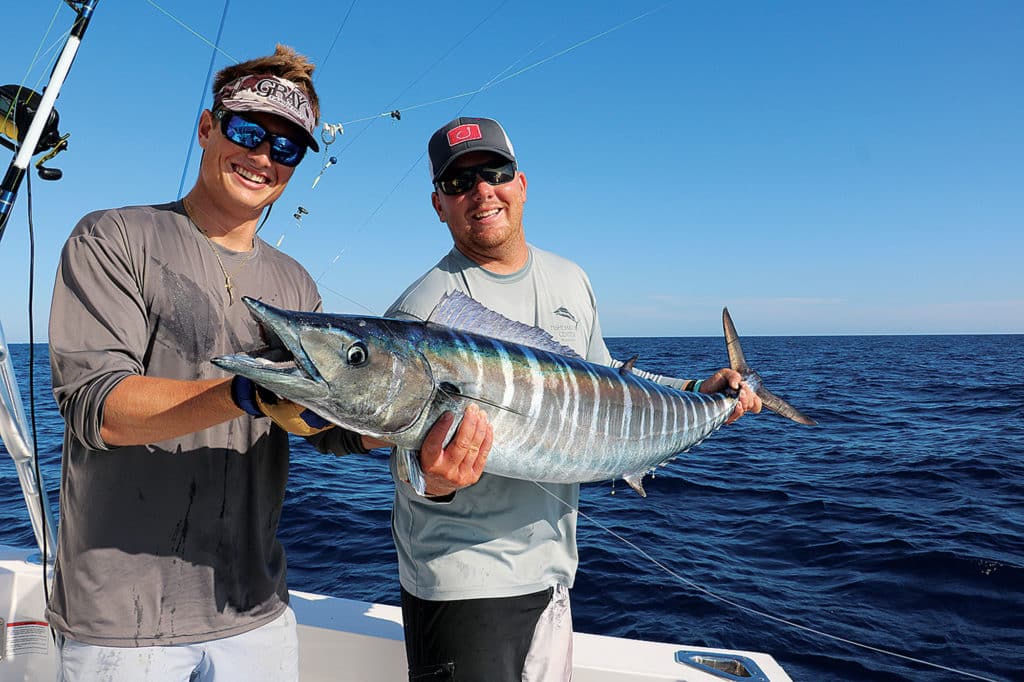
Toothy Encounter Suddenly, everyone’s attention swiveled astern as the clicker on the reel for the right long bait sang its alert. Pope wound fast in anticipation of a hookup, but the line never came tight. A toothy critter had severed the leader. As the crew rerigged, a fish attacked the right short line but with the same result — a clipped leader.
Moments later, there was a third strike. Something ate the goggle-eye on left long line. Davis wound tight. The line snapped free of the release clip, and this time the fish stuck. We all expected to see a leaping sailfish or mahi, but instead this fish staged a long, blistering run, then stayed high in the water column but never jumped.
“I think it’s a wahoo,” Davis said as he carefully played the fish. With that in mind — and a 30-pound-test fluorocarbon leader between us and the fish — no one expected a good outcome. Yet the battle and guessing game continued for another 15 minutes until deep color. I could make out the distinctive vertical bars. “It’s a wahoo,” I said. “Where’s the gaff?”
“We don’t have one,” Pope said. Unfortunately, while transferring tackle and gear from their regular ride — the Hatteras GT59 Hatterascal — to the Cabo 41, the crew forgot to bring a gaff. That’s not a big deal if you’re releasing sailfish, but now we had a tasty 40-plus-pound wahoo boatside on a thin leader.
Edward Gaffhands The deck crew came up with a plan. They would open the tuna door in the port side of the transom. Donahue would keep the Cabo slow ahead. I would hold the rod while Davis leadered the fish. Then Pope, wearing a pair of AFTCO Wire Max gloves, would lie on the deck and reach out through the tuna door to grab the wahoo from behind the gills. It was a risky move, but it worked, earning Pope the nickname of Edward Gaffhands.
As it turns out, the circle hook lodged in the snout of the wahoo. Any other hook position likely would have led to another clipped leader. In an amazing footnote, while cleaning the fish, Davis found three goggle-eyes in the stomach, two with our circle hooks and stubs of leader material, as well as the third bait that caught him — a case of fatal greed.
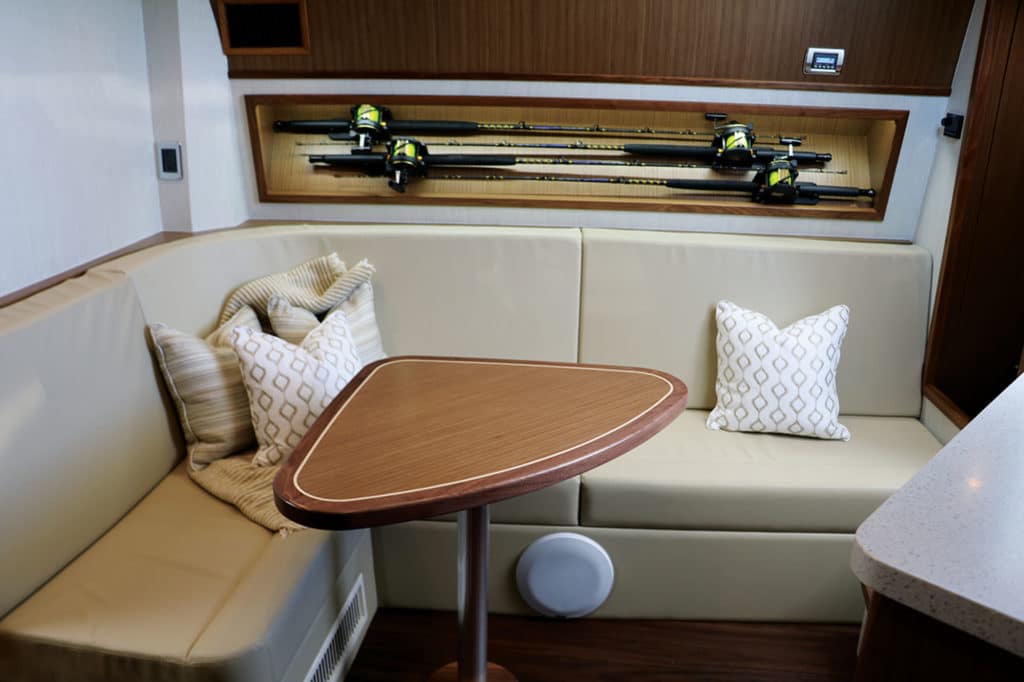
Speed and Fuel Numbers After three more hours of fishing that resulted in four more clipped leaders and one sailfish, we decided to head in to calm water and gather performance data on the Cabo 41. The twin turbo-diesels propelled the boat from zero to 30 mph in 12 seconds, reaching a top speed of 40.7 mph at 2,400 rpm where the D11s burned 74 gallons per hour for 0.55 mpg.
Read Next: Cabo 44 HTX Review
Optimal fuel efficiency occurred at 1,000 rpm and 10.8 mph where the Volvos consumed 9.9 gph for 1.1 mpg. That translates to a range of more than 540 miles based on 90 percent of the 550-gallon fuel capacity. If you’d like to cruise a bit faster, try 1,750 rpm and 26.9 mph, where the diesels burn 36 gph for 0.75 mpg. Leaving 10 percent fuel reserve, that’s a range of 370 miles.
Based on my long-time connection to the brand, news of the Cabo re-launch had given me reason to rejoice. I am happy to report that my time spent fishing aboard the 41 only reinforces that emotion.
Performance Power: Twin 725 hp Volvo Penta D11 turbo-diesels Load: 500 gal. fuel, four crew Top Speed: 40.7 mph @ 2,400 rpm Time to 30 MPH: 12 sec. Best MPG: 1.1 @ 9.9 mph (1,000 rpm)
Hull LOA: 42 ft. 10 in. (w/ bow pulpit) Beam: 15 ft. 9 in. Transom Deadrise: 15 deg. Dry Weight: 31,000 lbs. Draft: 3 ft. 5 in. Fuel: 550 gal. Max Power: 1,450 hp Base MSRP: $1,095,000 (w/ twin 625 hp Volvo Penta D11s)
Hatteras/Cabo Yachts New Bern, North Carolina 252-637-2226 hatterasyachts.com

